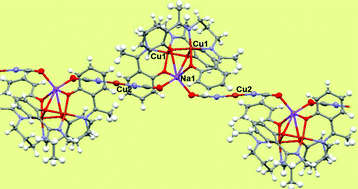NaI/CuI–II heterometallic cages interconnected by unusual linear 2-coordinate OCN-Cu(I)-NCO links: synthesis, structural, magnetostructural correlation and computational studies†
Abstract
A new

* Corresponding authors
a
Department of Chemistry, Jadavpur University, Raja S. C. Mullick Road, Kolkata, India
E-mail:
smitra_2002@yahoo.com
Fax: 91-33-2414 6414
Tel: 91-33-2414 6193
b School of Engineering and Physical Sciences, Heriot Watt University, Edinburgh, UK
c Department of Chemistry, Indian Institute of Technology Bombay, Powai, Mumbai, India
d Johannes Gutenberg - University of Mainz, Institute of Inorganic and Analytical Chemistry, Duesbergweg 10-14, Mainz
A new

 Please wait while we load your content...
Something went wrong. Try again?
Please wait while we load your content...
Something went wrong. Try again?
A. Ray, G. M. Rosair, R. Rajeev, R. B. Sunoj, E. Rentschler and S. Mitra, Dalton Trans., 2009, 9510 DOI: 10.1039/B911938H
To request permission to reproduce material from this article, please go to the Copyright Clearance Center request page.
If you are an author contributing to an RSC publication, you do not need to request permission provided correct acknowledgement is given.
If you are the author of this article, you do not need to request permission to reproduce figures and diagrams provided correct acknowledgement is given. If you want to reproduce the whole article in a third-party publication (excluding your thesis/dissertation for which permission is not required) please go to the Copyright Clearance Center request page.
Read more about how to correctly acknowledge RSC content.
 Fetching data from CrossRef.
Fetching data from CrossRef.
This may take some time to load.
Loading related content
